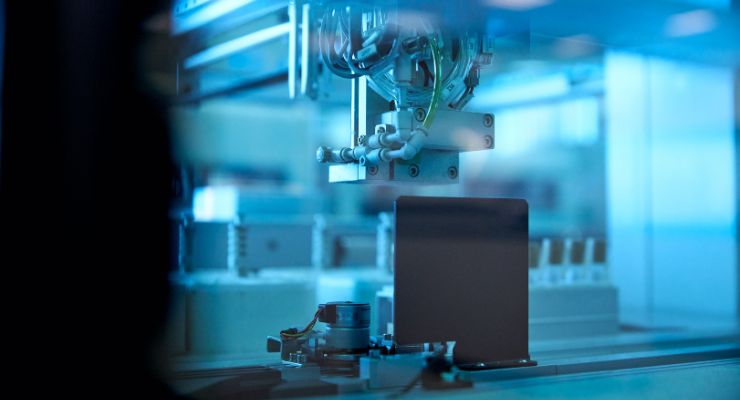Emily Newton, Editor-in-Chief, Revolutionized08.08.23
Artificial intelligence (AI) adoption is skyrocketing across virtually every industry. AI manufacturing holds particular promise, especially in high-precision, high-pressure subsectors like medical device production.
Medical manufacturers must understand how to apply AI effectively to fully capitalize on this potential. That begins with learning which use cases hold the most value in this specific industry, so here are the seven top AI applications transforming medical device manufacturing today.
The FDA authorized 91-enabled AI medical devices in 2022, signifying a huge market shift toward this technology. That evolution is understandable, as AI medical equipment can help doctors, nurses, and EMTs diagnose conditions faster and more accurately. New end uses will emerge as AI improves and becomes more reliable, expanding the market.
The demand for AI’s precision and speed will increase as labor challenges persist and care standards rise. Consequently, AI-capable medical devices will quickly take over the market, offering a promising opportunity for device developers today.
Machine learning tools can analyze demographic data in the pre-trial process to highlight ideal testing populations, including areas with willing participants. From there, AI tools can automate the outreach and data entry process for faster onboarding and more accurate record-keeping. As a result, manufacturers can begin trials in less time and remove errors in their documentation.
Using AI to automate the record-keeping process minimizes room for human error and speeds up data discovery and organization. Those improvements make it easier to provide regulatory bodies with accurate, relevant information faster, further streamlining the clinical trial process.
AI models can monitor product development data and compare it to the latest applicable regulatory framework. These algorithms can then highlight processes or documentation that introduces regulatory issues or warrants further investigation. Manufacturers can then revise their production or paperwork as necessary to remain compliant.
These fast, accurate noncompliance warnings become increasingly valuable as worldwide laws develop. Medical regulations will likely evolve due to the COVID-19 pandemic and the prominence of new technologies, so enabling quick adaptation is crucial to staying afloat.
Substantial improvements can come from easy-to-overlook changes. For example, air compressors are easier to maintain and more efficient than other equipment power sources, significantly improving uptime and energy spending. Still, manufacturers may overlook this opportunity because equipment powering systems aren’t as dramatic a change. Digital twins can find that solution where humans may miss it, unlocking savings.
These savings-finding simulations can benefit any manufacturer but are particularly important for medical device companies. These items are often expensive, making them inaccessible to some people, but process improvements can lower costs and customers’ barriers to entry. Digital twins can also minimize room for error to prevent noncompliant products from entering the market.
Studies show predictive maintenance reduces downtime by up to 50% by preventing breakdowns and minimizing unnecessary repair stops. It also lowers maintenance costs and ensures production machines deliver more consistent quality.
These improvements result in higher quality assurance for medical device company products, preventing costly legal consequences. Driving repair costs down also enables lower end prices like digital twins do.
Uncaught defects can lead to costly litigation in the medical device space, and AI can identify easy-to-miss errors more accurately than humans. It’s also faster than manual inspections, so thorough quality assurance doesn’t have to result in bottlenecks.
The other advantage of using AI for quality control is that intelligent algorithms can analyze data from defects to identify their source. Manufacturers can adapt their production lines accordingly to prevent future errors. That resource conservation is crucial in a sector as high-cost as medical devices.
AI tools can take a set of inputs about device goals and design considerations and draft a concept for what an ideal design should look like. Alternatively, manufacturers could use AI to analyze existing blueprints or prototypes to highlight changes that could make them more effective. They can then create better products to bring to market sooner.
Similarly, machine learning models can analyze consumer data to find underserved markets and unmet needs. Manufacturers can then target these niches with new products to boost sales with minimal competition.
Capitalizing on these seven applications enables medical device companies to improve margins, ensure regulatory compliance, boost efficiency, and help consumers overcome traditional cost barriers. AI will transform the sector as more manufacturers realize and act on these benefits.
 Emily Newton is the Editor-in-Chief of Revolutionized. She’s always excited to learn how the latest industry trends will improve the world. She has over five years of experience covering stories in the science and tech sectors.
Emily Newton is the Editor-in-Chief of Revolutionized. She’s always excited to learn how the latest industry trends will improve the world. She has over five years of experience covering stories in the science and tech sectors.
Medical manufacturers must understand how to apply AI effectively to fully capitalize on this potential. That begins with learning which use cases hold the most value in this specific industry, so here are the seven top AI applications transforming medical device manufacturing today.
1. AI-Enabled Devices
One of the most disruptive AI applications for manufacturers lies within medical products themselves. AI-equipped devices offer significant value to end users, so developing and selling these products can earn companies substantial revenue growth.The FDA authorized 91-enabled AI medical devices in 2022, signifying a huge market shift toward this technology. That evolution is understandable, as AI medical equipment can help doctors, nurses, and EMTs diagnose conditions faster and more accurately. New end uses will emerge as AI improves and becomes more reliable, expanding the market.
The demand for AI’s precision and speed will increase as labor challenges persist and care standards rise. Consequently, AI-capable medical devices will quickly take over the market, offering a promising opportunity for device developers today.
2. AI in Clinical Trials
Clinical trials represent another disruptive AI manufacturing application for medical device manufacturers. Attaining FDA 510(k) clearance takes 31 months on average and more than 130 months, in some cases. AI can streamline this process, enabling faster ROIs.Machine learning tools can analyze demographic data in the pre-trial process to highlight ideal testing populations, including areas with willing participants. From there, AI tools can automate the outreach and data entry process for faster onboarding and more accurate record-keeping. As a result, manufacturers can begin trials in less time and remove errors in their documentation.
Using AI to automate the record-keeping process minimizes room for human error and speeds up data discovery and organization. Those improvements make it easier to provide regulatory bodies with accurate, relevant information faster, further streamlining the clinical trial process.
3. AI for Regulatory Compliance
Similarly, medical device manufacturers can use AI to bolster their regulatory compliance. Balancing regulations between different countries can be complicated, with considerable room for human error, resulting in hefty fines. However, AI excels at complex analysis and data-heavy work.AI models can monitor product development data and compare it to the latest applicable regulatory framework. These algorithms can then highlight processes or documentation that introduces regulatory issues or warrants further investigation. Manufacturers can then revise their production or paperwork as necessary to remain compliant.
These fast, accurate noncompliance warnings become increasingly valuable as worldwide laws develop. Medical regulations will likely evolve due to the COVID-19 pandemic and the prominence of new technologies, so enabling quick adaptation is crucial to staying afloat.
4. Digital Twins
Digital twins are another promising AI manufacturing application for medical device companies. This technology uses AI to create digital replicas of real-world processes and equipment. Machine learning models can then simulate various events and changes in these twins to highlight inefficiencies and find ideal solutions.Substantial improvements can come from easy-to-overlook changes. For example, air compressors are easier to maintain and more efficient than other equipment power sources, significantly improving uptime and energy spending. Still, manufacturers may overlook this opportunity because equipment powering systems aren’t as dramatic a change. Digital twins can find that solution where humans may miss it, unlocking savings.
These savings-finding simulations can benefit any manufacturer but are particularly important for medical device companies. These items are often expensive, making them inaccessible to some people, but process improvements can lower costs and customers’ barriers to entry. Digital twins can also minimize room for error to prevent noncompliant products from entering the market.
5. Predictive Maintenance
Medical device manufacturing lines can also benefit from predictive maintenance, which uses AI to analyze real-time data from Internet of Things (IoT) sensors that monitor machine health factors. These AI models can then predict when equipment needs maintenance and alert relevant employees.Studies show predictive maintenance reduces downtime by up to 50% by preventing breakdowns and minimizing unnecessary repair stops. It also lowers maintenance costs and ensures production machines deliver more consistent quality.
These improvements result in higher quality assurance for medical device company products, preventing costly legal consequences. Driving repair costs down also enables lower end prices like digital twins do.
6. Machine Vision for Quality Control
Machine vision is another top AI manufacturing application medical device producers can benefit from. These systems can process and analyze visual data faster than the human eye, making them an ideal solution for quality control workflows.Uncaught defects can lead to costly litigation in the medical device space, and AI can identify easy-to-miss errors more accurately than humans. It’s also faster than manual inspections, so thorough quality assurance doesn’t have to result in bottlenecks.
The other advantage of using AI for quality control is that intelligent algorithms can analyze data from defects to identify their source. Manufacturers can adapt their production lines accordingly to prevent future errors. That resource conservation is crucial in a sector as high-cost as medical devices.
7. Product and Market Discovery
AI in manufacturing can help companies develop new product designs. Many pharmaceutical manufacturers use AI to identify new drugs, and device producers can apply similar models to kickstart or refine their offerings.AI tools can take a set of inputs about device goals and design considerations and draft a concept for what an ideal design should look like. Alternatively, manufacturers could use AI to analyze existing blueprints or prototypes to highlight changes that could make them more effective. They can then create better products to bring to market sooner.
Similarly, machine learning models can analyze consumer data to find underserved markets and unmet needs. Manufacturers can then target these niches with new products to boost sales with minimal competition.
AI Manufacturing Will Disrupt the Medical Device Sector
AI’s potential in manufacturing is vast. Medical devices—which often have high costs and must meet stringent standards—can benefit more than most products from this potential.Capitalizing on these seven applications enables medical device companies to improve margins, ensure regulatory compliance, boost efficiency, and help consumers overcome traditional cost barriers. AI will transform the sector as more manufacturers realize and act on these benefits.














